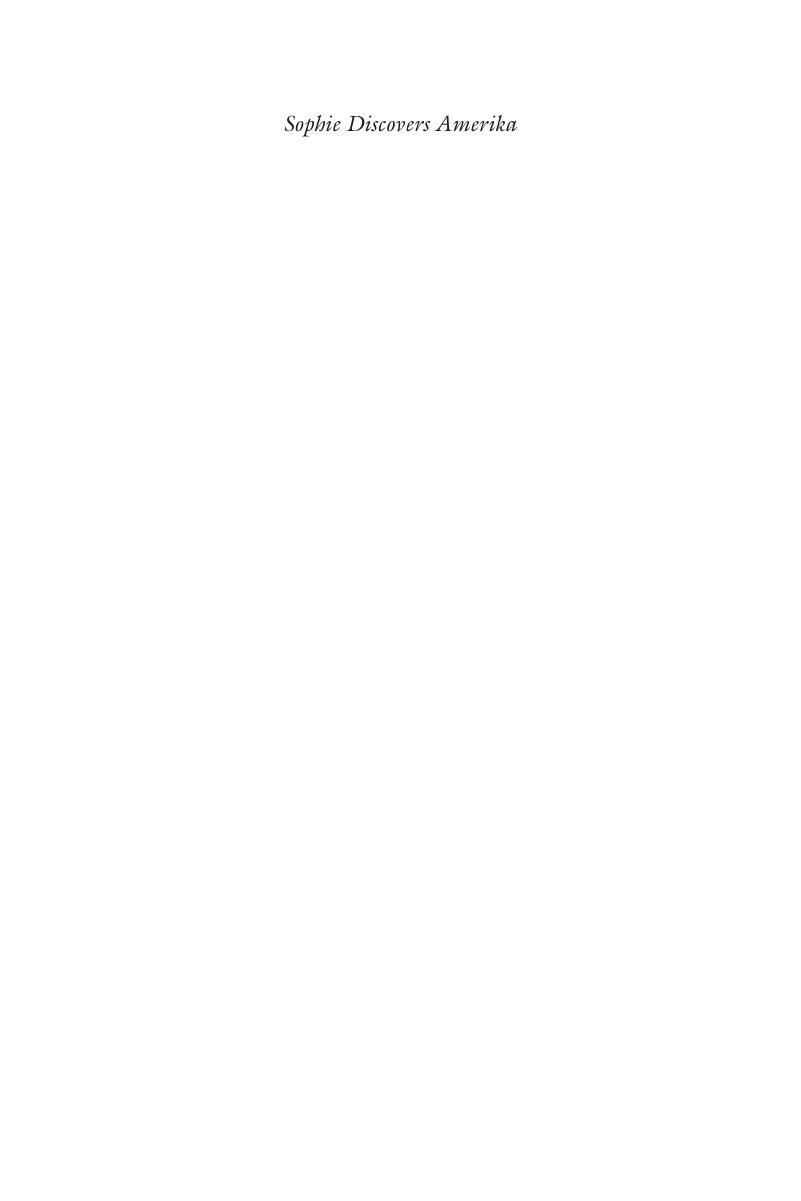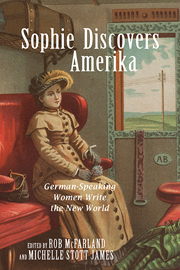Book contents
- Frontmatter
- Contents
- Foreword
- Acknowledgments
- Introduction
- 1 “Schwimme mit mir hinüber zu den Hütten unserer Nachbarn”: Colonial Islands in Sophie von La Roche's Erscheinungen am See Oneida (1798) and Jacques-Henri Bernardin de Saint-Pierre's Paul et Virginie (1788)
- 2 “Hier oder nirgends ist Amerika!”: America and the Idea of Autonomy in Sophie Mereau's “Elise” (1800)
- 3 A “Swiss Amazon” in the New World: Images of America in the Lebensbeschreibung of Regula Engel (1821)
- 4 Amalia Schoppe's Die Auswanderer nach Brasilien oder die Hütte am Gigitonhonha (1828)
- 5 Inscribed in the Body: Ida Pfeiffer's Reise in die neue Welt (1856)
- 6 Mathilde Franziska Anneke's Anti-Slavery Novella Uhland in Texas (1866)
- 7 “Ich bin ein Pioneer”: Sidonie Grünwald-Zerkowitz's Die Lieder der Mormonin (1887) and the Erotic Exploration of Exotic America
- 8 Seductive and Destructive: Argentina in Gabriele Reuter's Kolonistenvolk (1889)
- 9 Inventing America: German Racism and Colonial Dreams in Sophie Wörishöffer's Im Goldlande Kalifornien (1891)
- 10 Aus vergangenen Tagen: Eine Erzählung aus der Sklavenzeit (1906): Clara Berens's German American “Race Melodrama” in Its American Literary Contexts
- 11 “Der verfluchte Yankee!” Gabriele Reuter's Episode Hopkins (1889) and Der Amerikaner (1907)
- 12 Reframing the Poetics of the Aztec Empire: Gertrud Kolmar's “Die Aztekin” (1920)
- 13 Synthesis, Gender, and Race in Alice Salomon's Kultur im Werden (1924)
- 14 Land of Fantasy, Land of Fiction: Klara May's Mit Karl May durch Amerika (1931)
- 15 An Ideological Framing of Annemarie Schwarzenbach's Racialized Gaze: Writing and Shooting for the USA-Reportagen (1936–38)
- 16 “Fighting against Manitou”: German Identity and Ilse Schreiber' Canada Novels Die Schwestern aus Memel (1936) and Die Flucht in aradies (1939)
- 17 Mexico as a Model for How to Live in the Times of History: Anna Seghers's Crisanta (1951)
- 18 East Germany's Imaginary Indians: Liselotte Welskopf-Henrich's Harka Cycle (1951–63) and Its DEFA Adaptation Die Söhne der Großen Bärin (1966)
- 19 Finding Identity through Traveling the New World: Angela Krauß's Die Überfliegerin (1995) and Milliarden neuer Sterne (1999)
- 20 Discovery or Invention: Newfoundland in Gabrielle Alioth's Die Erfindung von Liebe und Tod (2003)
- 21 Tzveta Sofronieva's “Über das Glück nach der Lektüre von Schopenhauer, in Kalifornien” (2007)
- 22 “Amerika ist alles und das Gegenteil von allem. Amerika ist anders.” Milena Moser's Travel Guide to San Francisco (2008)
- Bibliography: The New World in German-Language Literature by Women
- Notes on the Contributors
- Index
Frontmatter
Published online by Cambridge University Press: 05 August 2014
- Frontmatter
- Contents
- Foreword
- Acknowledgments
- Introduction
- 1 “Schwimme mit mir hinüber zu den Hütten unserer Nachbarn”: Colonial Islands in Sophie von La Roche's Erscheinungen am See Oneida (1798) and Jacques-Henri Bernardin de Saint-Pierre's Paul et Virginie (1788)
- 2 “Hier oder nirgends ist Amerika!”: America and the Idea of Autonomy in Sophie Mereau's “Elise” (1800)
- 3 A “Swiss Amazon” in the New World: Images of America in the Lebensbeschreibung of Regula Engel (1821)
- 4 Amalia Schoppe's Die Auswanderer nach Brasilien oder die Hütte am Gigitonhonha (1828)
- 5 Inscribed in the Body: Ida Pfeiffer's Reise in die neue Welt (1856)
- 6 Mathilde Franziska Anneke's Anti-Slavery Novella Uhland in Texas (1866)
- 7 “Ich bin ein Pioneer”: Sidonie Grünwald-Zerkowitz's Die Lieder der Mormonin (1887) and the Erotic Exploration of Exotic America
- 8 Seductive and Destructive: Argentina in Gabriele Reuter's Kolonistenvolk (1889)
- 9 Inventing America: German Racism and Colonial Dreams in Sophie Wörishöffer's Im Goldlande Kalifornien (1891)
- 10 Aus vergangenen Tagen: Eine Erzählung aus der Sklavenzeit (1906): Clara Berens's German American “Race Melodrama” in Its American Literary Contexts
- 11 “Der verfluchte Yankee!” Gabriele Reuter's Episode Hopkins (1889) and Der Amerikaner (1907)
- 12 Reframing the Poetics of the Aztec Empire: Gertrud Kolmar's “Die Aztekin” (1920)
- 13 Synthesis, Gender, and Race in Alice Salomon's Kultur im Werden (1924)
- 14 Land of Fantasy, Land of Fiction: Klara May's Mit Karl May durch Amerika (1931)
- 15 An Ideological Framing of Annemarie Schwarzenbach's Racialized Gaze: Writing and Shooting for the USA-Reportagen (1936–38)
- 16 “Fighting against Manitou”: German Identity and Ilse Schreiber' Canada Novels Die Schwestern aus Memel (1936) and Die Flucht in aradies (1939)
- 17 Mexico as a Model for How to Live in the Times of History: Anna Seghers's Crisanta (1951)
- 18 East Germany's Imaginary Indians: Liselotte Welskopf-Henrich's Harka Cycle (1951–63) and Its DEFA Adaptation Die Söhne der Großen Bärin (1966)
- 19 Finding Identity through Traveling the New World: Angela Krauß's Die Überfliegerin (1995) and Milliarden neuer Sterne (1999)
- 20 Discovery or Invention: Newfoundland in Gabrielle Alioth's Die Erfindung von Liebe und Tod (2003)
- 21 Tzveta Sofronieva's “Über das Glück nach der Lektüre von Schopenhauer, in Kalifornien” (2007)
- 22 “Amerika ist alles und das Gegenteil von allem. Amerika ist anders.” Milena Moser's Travel Guide to San Francisco (2008)
- Bibliography: The New World in German-Language Literature by Women
- Notes on the Contributors
- Index
Summary

- Type
- Chapter
- Information
- Sophie Discovers AmerikaGerman-Speaking Women Write the New World, pp. i - ivPublisher: Boydell & BrewerPrint publication year: 2014

